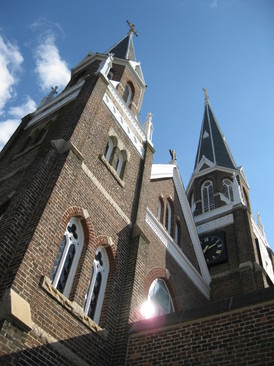This place was made by God, an inestimably holy place. It is without reproof.
Most people are accustomed to celebrating anniversaries: wedding, ordination, religious profession, moving to a new place, etc. From time immemorial the Church has celebrated the anniversary of a church's dedication; there are notable examples of this in the liturgical calendar, e.g., Dedication of the Lateran Basilica. Today, in the life of the Diocese of Charlotte and the monks of Mary Help of Christian - Belmont Abbey, the Abbey Basilica is honored because of it consecration in 1965 by Abbot Walter Coggin, abbot nullius. Dom Agostino celebrated the conventual Mass. The wonderful drama of the Liturgies since first Vespers last evening has been the 12 dedication candles lit. They are rearely lit even in the most liturgically sensible places that seeing them glow is just wonderful. Wouldn't it be a good thing if pastors lit the dedication candles on all the feasts of the Lord and the feasts of the apostles!
The point of the festive Mass on such an anniversary and the use of special antiphons used in the Divine Office is honor God by keeping sincere our worship in the saving love of this church. It is also a keen reminder that we find our refuge in the Lord while praying in spirit and truth. Some points from recent ecclesial documents may help focus our attention on the meaning of the Church: In 1892 Abbot-Bishop Leo Michael Haid blessed and laid the cornerstone for the abbey church which in time became the cathedral for the Apostolic Vicariate (founded in 1910). This church had two significant uses: it was the church in which the monks daily prayed and it was the heart of Catholic life for the state of
In 1892 Abbot-Bishop Leo Michael Haid blessed and laid the cornerstone for the abbey church which in time became the cathedral for the Apostolic Vicariate (founded in 1910). This church had two significant uses: it was the church in which the monks daily prayed and it was the heart of Catholic life for the state of
The church building is a sign and reminder of the immanence and transcendence of God --who chose to dwell among us and whose presence cannot be contained or limited to any single place. ...Churches are signs of the pilgrim church on earth; they are images that proclaim the heavenly
The dedication of a church, especially a cathedral, is a significant and rare event in the life of a Christian community. It involves more than merely setting aside a building for the celebration of sacred things, since the people who plan, build, and dedicate a sacred
place are themselves the Church, "that is, the
in the Eucharist." (Rite for the Dedication of a Church and an Altar, chapter 2, no. 1)
This building is both the house of God on earth (domus Dei) and a house fit for
the prayers of the saints (domus ecclesiae). (Built of Living Stones, no. 16)
O how amiable are thy dwellings: thou Lord of hosts!
My soul hath a desire and a longing to enter into the courts of the Lord:
My heart and my flesh rejoice in the living God.
Yea, the sparrow hath found her a house,
and the swallow a nest where she may lay her young:
even the altars, O Lord of hosts, my King and my God.
Blessed are they that dwell in thy house: they will be always praising thee.
The glorious Majesty of the Lord our God be upon us:
prosper thou the work of our hands upon us.
O prosper thou our handywork, O prosper thou our handywork.
O God our help in ages past, Our hope for years to come,
Our shelter from the stormy blast, And our eternal home.
(Text Psalms 84 & 90; Isaac Watts (1674-1748))


Great stuff. I've never been in a parish that celebrated their proper solemnity of dedication, but it would such a great opportunity for local pride and solidarity. Plus perhaps a chance to sing that great introit, Terribilis est locus iste...